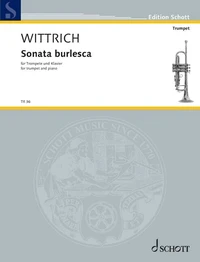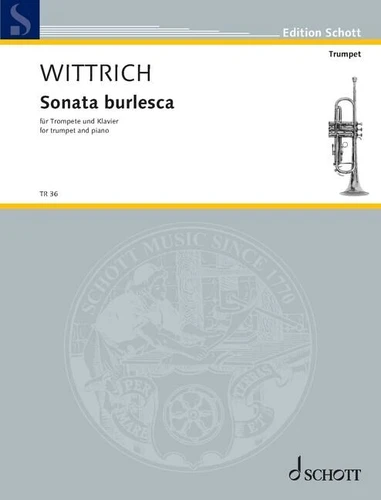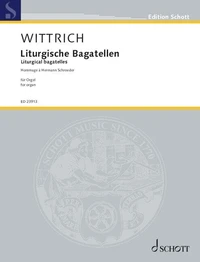The title Sonata burlesca already hints at the jocular, entertaining character of the piece. Many years of working together, particularly with brass players, gave me the desire to write an entertaining, contemporary work that would be fun for professionals, but especially for young performers, also with regard to "Jugend musiziert" (age groups 3-4), to be able to shine with a technically challenging work and to awaken in them a desire for something new.
The tonal character, modelled freely in keeping with the spirit of the times, creates familiarity in all movements, with the Blues even taking a detour into "jazz". By using different mutes, special tone colours are exploited on the trumpet. All these translucent characteristics "in stile di Divertimento" guarantee a consistently self-explanatory approach. In the first movement - in free reference to the sonata form - three themes are juxtaposed.
A fanfare theme corresponding to the character of the trumpet dominates the two more lyrical, song-like secondary themes. The Blues takes up idiomatic turns of phrase from jazz, e. g. the walking bass and small motif building blocks called 'licks', and deforms them in favour of modern means of expression. The familiar 12-bar blues scheme is dispensed with ; formally and harmonically, the Blues seeks its own path.
What shall we do with the Drunken Sailor, a famous shanty, is the protagonist of the third movement. The triadic shifts derived from the melody and the final pentatonic melodic cadence generate numerous metamorphoses under toccata-like accompaniment patterns. A splash of virtuosity is not to be missed in the final movement as a means of escalation and the motoric and rousing basic ductus maintains the cheerful attitude until the end.
Buon divertimento ! I would like to thank my long-time friend and interpreter of the first performance Manfred Bockschwaiger for some valuable advice. Peter Wittrich, in May 2025 Instrumentation : trumpet in Bb and piano
The title Sonata burlesca already hints at the jocular, entertaining character of the piece. Many years of working together, particularly with brass players, gave me the desire to write an entertaining, contemporary work that would be fun for professionals, but especially for young performers, also with regard to "Jugend musiziert" (age groups 3-4), to be able to shine with a technically challenging work and to awaken in them a desire for something new.
The tonal character, modelled freely in keeping with the spirit of the times, creates familiarity in all movements, with the Blues even taking a detour into "jazz". By using different mutes, special tone colours are exploited on the trumpet. All these translucent characteristics "in stile di Divertimento" guarantee a consistently self-explanatory approach. In the first movement - in free reference to the sonata form - three themes are juxtaposed.
A fanfare theme corresponding to the character of the trumpet dominates the two more lyrical, song-like secondary themes. The Blues takes up idiomatic turns of phrase from jazz, e. g. the walking bass and small motif building blocks called 'licks', and deforms them in favour of modern means of expression. The familiar 12-bar blues scheme is dispensed with ; formally and harmonically, the Blues seeks its own path.
What shall we do with the Drunken Sailor, a famous shanty, is the protagonist of the third movement. The triadic shifts derived from the melody and the final pentatonic melodic cadence generate numerous metamorphoses under toccata-like accompaniment patterns. A splash of virtuosity is not to be missed in the final movement as a means of escalation and the motoric and rousing basic ductus maintains the cheerful attitude until the end.
Buon divertimento ! I would like to thank my long-time friend and interpreter of the first performance Manfred Bockschwaiger for some valuable advice. Peter Wittrich, in May 2025 Instrumentation : trumpet in Bb and piano







